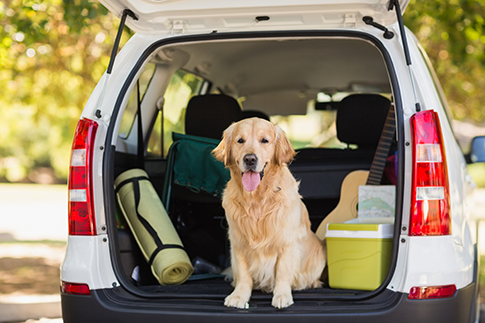Travelling with your pet

Here’s everything you need to know to ensure problem-free travels in Canada or abroad with Fido or Kitty.
Before travelling with your pet
If you want to travel with your pet, it’s best not to leave anything to chance, so plan well in advance.
- Contact airlines to find out what their animal transportation policies are, and read up on regulations in the country or countries you’ll be visiting.
- Many countries require a health certificate signed by professional along with proof that the animal has been vaccinated against rabies and has a microchip implant.
- Make a vet appointment for six weeks before you leave, to have all your pet’s vaccines updated.
- Make sure you have a suitable cage, and learn the best strategies for preparing your pet for the long trip.
- If you have pet insurance, find out what coverage applies when you are travelling, and make adjustments to the policy if need be.
A forewarned master makes for a forearmed pet!
Transporting your pet by car

Your first time driving down to sunny, warm Florida to escape Quebec’s winter chill? Be aware that the rules are the same for pets whether you arrive by air or by road.
- Keep your animal’s health certificate and vaccine record handy to ensure a trouble-free border crossing. Dogs must be vaccinated against rabies, while all pet food must be in its original Canadian or U.S. packaging, and sealed. Food containing lamb, mutton or goat is forbidden.
- If you are travelling with your dog, make sure it is secured in a large crate or by a restraining harness so as not to interfere with the driver’s movements.
- Be sure to stop at least every three hours so your dog can do its business, drink water and stretch its legs.
- Don’t let your pet put its head out the window: this damages its eyes and ears—not to mention that if you stop suddenly, your animal could be thrown from the car.
- Some animals, like cats, travel better if they are comfortably settled in a cage.
- Get in touch with the veterinary clinic nearest to your vacation home, and plan alternative arrangements in case you need to return home early.
Travelling by air with your pet
Obviously, your pet’s size and weight are factors in determining which method of transportation is best for it.
- In the cabin
Some air carriers allow passengers to fly with their cat or a small dog with them in the cabin, for an extra fee. The animal must remain in a cage under the seat in front of you at all times.
- In the baggage hold
Most aircraft have a pressurized baggage hold that will accommodate cats and dogs. For a few hundred dollars, your pet will be safely transported to your destination, as long as it is in a secure cage properly suited to its needs.
- As cargo
This is the ideal method for safely transporting larger dogs as well as exotic pets. The animals travel on a separate flight, but the shipping company takes proper care of them and assumes full responsibility for its animal cargo. The only hitch is that airfare for your pet can cost twice as much as for you.
Planning thoroughly to avoid inconvenience
Many hotels and restaurants in Quebec do not allow dogs, so it’s important to check before departure whether yours will be welcome where you plan to go. The same applies to campgrounds: some accept pets, but only as long as they remain in certain locations. It’s a good idea to plan your itinerary to that your pet won’t be confined to your RV while you’re enjoying a day at the beach. The rules are often looser in the U.S. and in European countries, but you should still make all necessary checks before booking. If you plan to go to a lot of restaurants, find out which ones allow dogs on their outdoor terrace, to avoid unpleasant surprises. Travelling with pets can be a very pleasant experience, especially considering that they can spark interesting conversations with other travellers or local residents. Just be sure to properly prepare your trip to help your animal companion travel the world with you.
Insurance matters!
- Does my emergency medical care travel insurance cover my pet as well as me?
The vast majority of insurers do not cover health care for your pets, even though you may think of them as family.
CAA-Quebec Travel Insurance is a rare exception! It does cover reimbursement for emergency veterinary services, up to a maximum of $300, in the event one or more of your pets suffers an accidental bodily injury while accompanying you during your trip.
- My dog has just died, just as I was preparing to go on a trip. Can I cancel my travel plans and be reimbursed?
It depends on the insurer you dealt with and the policy you took out. Some companies won’t cover trip cancellation for this reason, while others have specific clauses for animal bereavement.
- If I’m travelling with my pet and I’m injured and taken to hospital, what will happen to my pet?
Most insurance companies will cover expenses incurred for the return of the insured person’s pet, but only in the event of an emergency return to their home province. The company’s assistance services or concierge service, or special pet insurance coverage, can also be a great help.
The best option is to purchase insurance specially adapted to your pets, to ensure your peace of mind whenever you travel together.

Protect your dogs and cats
See how you could avoid spending so much on veterinary bills.